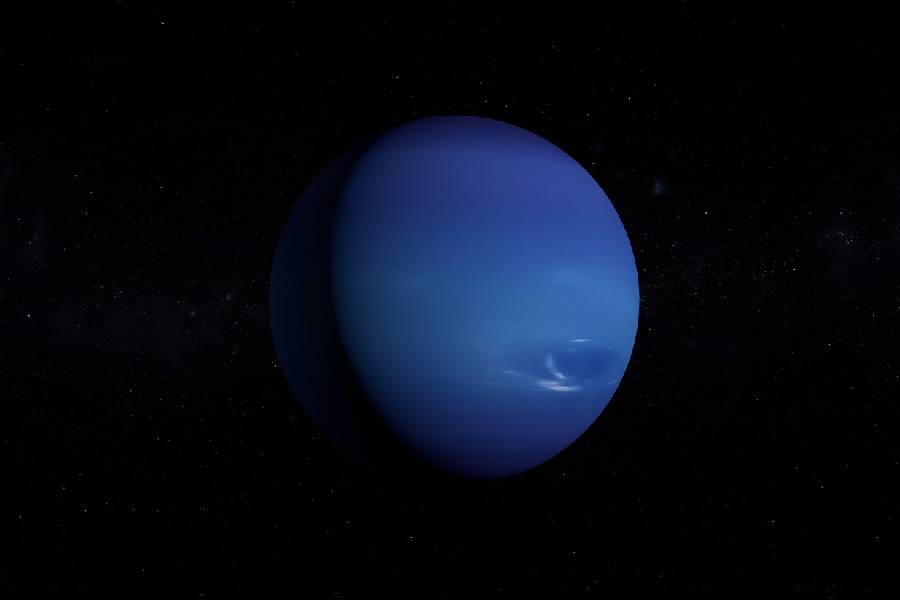Shrouded in churning clouds and mystery, Neptune climate has captivated astronomers since its discovery. This distant, icy giant boasts the strongest winds observed in the solar system, with velocities exceeding a staggering 1,200 mph.
Unraveling the intricacies of Neptune’s climate poses a significant challenge, as the planet resides 30 times farther from the Sun than Earth. Yet new insights shed light on the contributing factors shaping this enigmatic world.
We will examine the influences that drive Neptune’s weather and seasons, patterns that emerge in its storm systems and winds, how its atmosphere differs from the other gas giants, and the open questions atmospheric scientists hope to answer.
As observations and modeling capabilities advance, the mysteries surrounding Neptune’s meteorology and climate may gradually unravel, revealing intricacies unlike anywhere else in our solar system.
Neptune Climate
The climate on Neptune is characterized by extreme winds, turbulent weather patterns, and a dynamic atmosphere. Neptune is a gas giant with a thick atmosphere primarily composed of hydrogen, helium, and traces of methane.
The planet experiences powerful winds that can reach speeds of over 1,500 miles per hour (2,400 kilometers per hour), making them some of the fastest in the solar system.
Neptune’s dynamic climate is characterized by tumultuous storms, fast-changing weather patterns, and extreme temperature variations. However, the mechanisms driving its atmospheric turbulence remain shrouded in uncertainty.

Climate Zones and Variability on Neptune
Neptune, the eighth and farthest known planet from the Sun, boasts a dynamic climate characterized by extreme atmospheric conditions and distinct climate zones. Delving into the intricacies of Neptune’s climate zones provides valuable insights into the complex workings of this ice giant.
Neptune’s Climate Zones
Neptune’s atmosphere is not homogenous but exhibits varied climate zones, each contributing to the planet’s overall meteorological landscape. These zones are defined by differences in temperature, pressure, and atmospheric composition.
Equatorial zone
The equatorial zone, positioned near Neptune’s equator, experiences relatively milder temperature fluctuations compared to other regions.
The moderating effect on temperatures can be attributed to the equatorial location, where the angle of sunlight exposure remains relatively consistent throughout the year. It leads to more stabilized and predictable temperature patterns.
Polar regions
The polar regions of Neptune are marked by extreme cold and unique atmospheric phenomena. The axial tilt is instrumental in generating more pronounced seasonal variations in the polar regions, where the angle of sunlight varies more widely throughout the Neptunian year.
The extreme cold observed in these polar zones is a direct consequence of the limited exposure to sunlight, which results in frigid temperatures.
Tropical bands
Nestled between the equatorial and polar regions, the tropical bands on Neptune boast a distinctive blend of atmospheric characteristics and dynamic weather phenomena.
In this transitional zone, prominent features include the prevalence of vibrant cloud formations, intermittent storm systems, and notable temperature fluctuations. Interactions between different air masses and atmospheric circulation contribute to the variability observed in the tropical bands.
Factors Contributing to Variability
Winds and atmospheric dynamics
Neptune experiences some of the fastest winds in the solar system, reaching speeds exceeding 1,500 miles per hour (2,400 kilometers per hour). These high-speed winds contribute significantly to the planet’s atmospheric variability.
Magnetic field influence
The strong magnetic field of Neptune influences its climate by interacting with charged particles in the atmosphere. This interaction contributes to the planet’s auroras and may play a role in shaping climate patterns.
Seasonal changes
Despite its considerable distance from the Sun, Neptune undergoes seasonal changes due to its axial tilt. The variation in sunlight and heating across different latitudes results in distinct climate zones and seasonal fluctuations.
Atmospheric composition
The composition of Neptune’s atmosphere, primarily consisting of hydrogen, helium, and methane, contributes to the formation of clouds and storms. Variations in the distribution of these elements influence climate variability.
Understanding the different climate zones on Neptune and the factors contributing to variability is crucial for unraveling the mysteries of this distant ice giant.
Ongoing advancements in observational technology and space exploration continue to enhance our knowledge of Neptune’s dynamic and ever-changing climate.

Weather Patterns on Neptune
Neptune’s weather patterns are marked by extreme turbulence, powerful winds, and captivating atmospheric features. Exploring the dynamic weather on Neptune provides valuable insights into the atmospheric processes that govern this distant ice giant.
High-speed winds
Neptune experiences some of the fastest winds in the solar system, with speeds exceeding 1,500 miles per hour (2,400 kilometers per hour). These supersonic winds contribute to the planet’s turbulent and ever-changing weather patterns.
Great Dark Spot
The Great Dark Spot is a prominent atmospheric feature on Neptune, akin to Jupiter’s Great Red Spot. This massive storm system, characterized by a dark vortex, exhibits complex dynamics and can change in appearance over time.
Atmospheric Turbulence
The extreme winds and complex atmospheric dynamics on Neptune lead to turbulent weather conditions. Understanding these patterns requires studying the interactions of different gasses and cloud layers.
Seasonal Changes
Despite its significant distance from the Sun, Neptune undergoes seasonal changes due to its axial tilt. These changes contribute to variations in weather patterns, creating distinct climatic zones.
Other atmospheric features
Neptune’s atmosphere hosts bright clouds, likely composed of methane ice crystals. These clouds contribute to the planet’s reflective appearance.
In addition to the Great Dark Spot, Neptune experiences various storm systems and cloud formations, creating a dynamic and visually striking atmospheric landscape.
Magnetic Field and Its Influence on Neptune
Neptune’s magnetic field stands as one of this distant ice giant’s most powerful and intriguing features. Unraveling the mysteries of Neptune’s magnetic field not only sheds light on the planet’s internal dynamics but also unveils its profound influence on climate and atmospheric processes.
Neptune boasts a powerful magnetic field, approximately 27 times stronger than Earth’s. This magnetic strength is second only to Jupiter’s in our solar system. The source of this intense magnetic field is believed to be the planet’s dynamic and convecting mantle.
Formation and characteristics
Neptune’s magnetic field is likely generated by the motion of electrically conducting fluids in its interior, similar to Earth’s geodynamo. The magnetic field is tilted relative to the planet’s rotation axis, contributing to its complex and dynamic nature.
Interaction with the atmosphere
Neptune’s magnetic field plays a pivotal role in shaping the planet’s atmosphere. It interacts with charged particles in the atmosphere, influencing the distribution of gasses and contributing to the formation of auroras near the magnetic poles.
Effects on atmospheric dynamics
The strong magnetic field affects the behavior of charged particles in Neptune’s atmosphere, influencing atmospheric circulation and contributing to the planet’s dynamic weather patterns. Understanding these interactions is crucial for deciphering the complexity of Neptune’s atmospheric dynamics.
Influence on climate
Neptune’s magnetic field is intricately linked to its climate. The interaction between the magnetic field and solar wind, as well as the modulation of atmospheric conductivity, contributes to the planet’s overall climate variability.
Auroras and magnetosphere
Neptune’s magnetic field gives rise to spectacular auroras near its poles, similar to Earth’s northern and southern lights. These auroras offer visual evidence of the intricate interplay between the magnetic field and the planet’s atmosphere.

Conclusion
Neptune’s dynamic and turbulent climate remains shrouded in mystery despite recent revelations. Its extreme winds, captivating storms, and variability across climate zones showcase an alien world unlike any in our solar system.
While major challenges exist in unraveling the intricacies of Neptune’s climate from afar, ongoing improvements in observational capabilities offer hope of piercing the haze surrounding this icy giant.
As more pieces of the puzzle emerge, from magnetic field influences to seasonal shifts, our comprehension of the mechanisms governing Neptune’s weather grows.
We hope this overview has illuminated some of the recent discoveries starting to peel back the layers of complexity inherent to Neptune climate. Much work remains to comprehend the inner workings of this mysterious world truly, but each revelation inches us toward a clearer picture of Neptune’s meteorological marvels.

